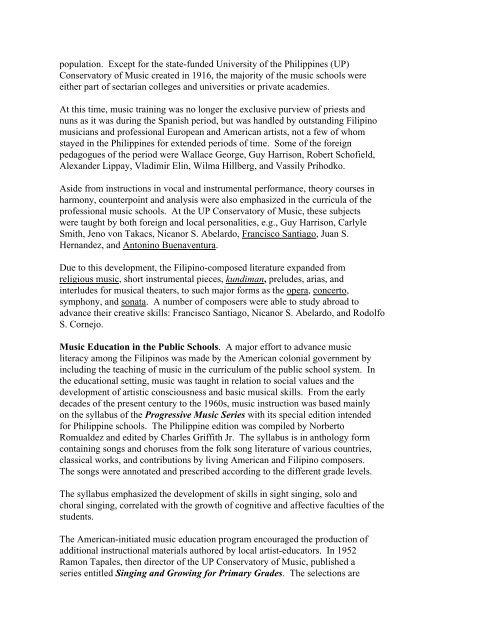THE AMERICAN COLONIAL AND CONTEMPORARY TRADITIONS ...
THE AMERICAN COLONIAL AND CONTEMPORARY TRADITIONS ...
THE AMERICAN COLONIAL AND CONTEMPORARY TRADITIONS ...
Create successful ePaper yourself
Turn your PDF publications into a flip-book with our unique Google optimized e-Paper software.
population. Except for the state-funded University of the Philippines (UP)<br />
Conservatory of Music created in 1916, the majority of the music schools were<br />
either part of sectarian colleges and universities or private academies.<br />
At this time, music training was no longer the exclusive purview of priests and<br />
nuns as it was during the Spanish period, but was handled by outstanding Filipino<br />
musicians and professional European and American artists, not a few of whom<br />
stayed in the Philippines for extended periods of time. Some of the foreign<br />
pedagogues of the period were Wallace George, Guy Harrison, Robert Schofield,<br />
Alexander Lippay, Vladimir Elin, Wilma Hillberg, and Vassily Prihodko.<br />
Aside from instructions in vocal and instrumental performance, theory courses in<br />
harmony, counterpoint and analysis were also emphasized in the curricula of the<br />
professional music schools. At the UP Conservatory of Music, these subjects<br />
were taught by both foreign and local personalities, e.g., Guy Harrison, Carlyle<br />
Smith, Jeno von Takacs, Nicanor S. Abelardo, Francisco Santiago, Juan S.<br />
Hernandez, and Antonino Buenaventura.<br />
Due to this development, the Filipino-composed literature expanded from<br />
religious music, short instrumental pieces, kundiman, preludes, arias, and<br />
interludes for musical theaters, to such major forms as the opera, concerto,<br />
symphony, and sonata. A number of composers were able to study abroad to<br />
advance their creative skills: Francisco Santiago, Nicanor S. Abelardo, and Rodolfo<br />
S. Cornejo.<br />
Music Education in the Public Schools. A major effort to advance music<br />
literacy among the Filipinos was made by the American colonial government by<br />
including the teaching of music in the curriculum of the public school system. In<br />
the educational setting, music was taught in relation to social values and the<br />
development of artistic consciousness and basic musical skills. From the early<br />
decades of the present century to the 1960s, music instruction was based mainly<br />
on the syllabus of the Progressive Music Series with its special edition intended<br />
for Philippine schools. The Philippine edition was compiled by Norberto<br />
Romualdez and edited by Charles Griffith Jr. The syllabus is in anthology form<br />
containing songs and choruses from the folk song literature of various countries,<br />
classical works, and contributions by living American and Filipino composers.<br />
The songs were annotated and prescribed according to the different grade levels.<br />
The syllabus emphasized the development of skills in sight singing, solo and<br />
choral singing, correlated with the growth of cognitive and affective faculties of the<br />
students.<br />
The American-initiated music education program encouraged the production of<br />
additional instructional materials authored by local artist-educators. In 1952<br />
Ramon Tapales, then director of the UP Conservatory of Music, published a<br />
series entitled Singing and Growing for Primary Grades. The selections are

















